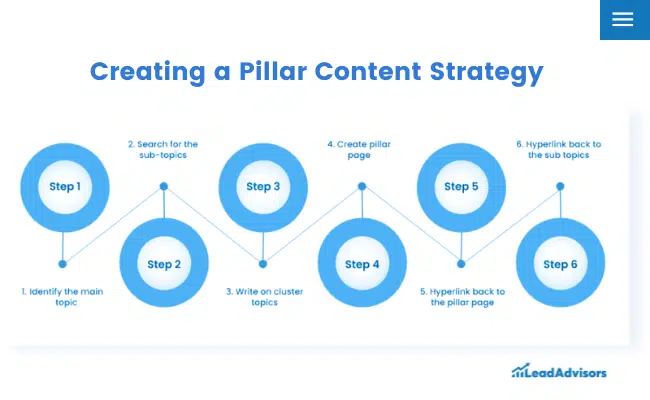Want your e-commerce business to stand out in a crowded online marketplace? Attracting and engaging your target audience can be tough when competitors are everywhere. One proven approach that top-performing brands use to boost visibility is the pillar content strategy – a method designed to capture attention, keep visitors engaged, and drive steady growth.
SmartAcre’s pillar content campaign delivered results in just four weeks: a 53% jump in page views, a 20% increase in organic leads, and dramatic growth for linked blogs – one post saw traffic surge by over 1,200%. This guide will walk you through building your pillar content strategy, from crafting high-value pillar pages to promoting them effectively and measuring their impact.
What is Pillar Content?

Pillar content lies at the heart of an effective blog content and marketing strategy. Unlike regular blog posts that cover specific topics in detail, pillar content serves as comprehensive, authoritative pieces that provide a strong foundation for your website.
Pillar content goes beyond a blog post or content addressing a single topic.
- It explores a vast topic or subject matter in-depth,
- Offer valuable insights and guidance to your target audience.
This content establishes your expertise in a broad topic, builds credibility, and attracts organic traffic over time.
One key aspect of pillar content is its association with topic clusters. A topic cluster comprises a central pillar page that acts as the topic cluster content’s main hub or core resource, accompanied by several subtopic articles interlinked with the pillar page. This interconnected structure of internal links helps search engines understand the relevance and authority of related keywords in your content, leading to improved rankings in search results.
Creating a Pillar Content Strategy

Developing a pillar content strategy requires
- careful planning,
- keyword research,
- and execution to create content pillars that align with business goals and target audience interests.
The first step is conducting keyword research and identifying high-value keywords and topics that will serve as the foundation for the pillar content. These keywords should have significant search volume and relevance to the target audience.
After identifying pillar topics, the next step is to plan and organize subtopics that revolve around each pillar. These subtopics should cover different aspects of the main subject and provide comprehensive coverage. Each subtopic will have its own dedicated blog post or article.
Mapping out the interlinking structure of the pillar content is crucial. This involves creating a linking structure where each subtopic article links back to the corresponding pillar page. This internal linking strategy strengthens the authority of the pillar page and enhances user navigation through related content.
Crafting Pillar Content
Developing these subtopics and coordinating writers or designers requires a clear content production process to maintain consistency and quality. It involves choosing broad, evergreen topics that remain relevant over time. Evergreen topics provide a strong foundation for your pillar content.
Conducting in-depth research and incorporating data and statistics is crucial. Backing your content with reliable research establishes credibility and authority. Thoroughly research and cite reputable sources to enhance the value and trustworthiness of your pillar content.
Structuring pillar content with logical sections and subheadings improves readability and user experience. Organize your content into meaningful sections and use descriptive subheadings that guide readers and facilitate easy navigation.
Optimizing pillar content for search engines is essential. Implement on-page optimization techniques to improve search engine visibility. Include relevant keywords, optimize meta tags, use descriptive URLs, and ensure scannability with bullet points, lists, and relevant images.
Why is Pillar Content Important for Small Businesses?

As small businesses seek to establish themselves in a crowded marketplace, it’s critical to create content that drives engagement, builds relationships, and establishes thought leadership.
That’s where pillar content comes in. Pillar content is a comprehensive, in-depth piece of content that covers a broad topic in your industry, providing your audience with a one-stop shop for everything they need to know about that subject.
But why is pillar content so important for small businesses? Here are five reasons:
1. Establishes Thought Leadership
By creating pillar content, small businesses can demonstrate their expertise in their respective industries. When you cover a broad topic in your industry comprehensively, you position yourself as a go-to source of information in your field.
This, in turn, helps to establish you as a thought leader, someone who has a deep understanding of the challenges and opportunities in your industry.
2. Builds Trust and Authority
When you provide your audience with valuable, informative content, you build trust and authority with them. By creating well-researched, well-written, and well-designed pillar content, you show your audience that you take your business seriously and that you’re committed to providing them with the best possible experience.
3. Drives Traffic and Engagement
Pillar content is often evergreen, meaning it doesn’t go out of date quickly. By creating this type of content, you’re providing your audience with something that they can come back to time and time again. This, in turn, can drive traffic to your website and increase engagement with your brand.
4. Facilitates Content Creation
Pillar content can serve as a foundation for a variety of other types of content, including blog posts, social media updates, videos, podcasts, and more.
By creating this core piece of content, you can use it as a jumping-off point for other types of content, making it easier to create a consistent stream of valuable content for your audience.
5. Increases SEO Visibility
Pillar content tends to be long-form, meaning it’s often several thousand words in length. This length allows you to cover a topic comprehensively, which can increase your chances of ranking well in search engine results pages (SERPs).
Promoting and Updating Pillar Content

Promoting your pillar content and ensuring its success requires proactive strategies and diligent efforts. Below are some strategies for promoting and updating your pillar content strategy.
If you want to improve your search engine rankings, LeadAdvisors can help you create, update, and promote informative, engaging, and effective pillar content.
Harness the Power of Social Media:
Social media platforms are invaluable for promoting your pillar content to a broader audience, but it’s important to understand the pros and cons of social media marketing before choosing your approach. Share your pillar content across your social media channels, crafting engaging captions that entice users to click and explore cluster content further.
Motivate your audience to share your valuable content with their networks, amplifying its reach and influence. Engage with your audience through comments and messages to foster meaningful connections and build community.
Leverage Email Marketing:
Your email subscriber list is a powerful asset for promoting and updating your pillar content. Craft compelling newsletters or dedicated emails highlighting your pillar content, providing a sneak peek or valuable insights.
Dividing your email subscribers into segments can provide personalized and relevant content that deeply connects with each recipient. This increases engagement and encourages them to share valuable content with their contacts, leading to more traffic and potential backlinks.
Embrace Influencer Outreach:
Collaborating with influencers or industry experts can significantly boost the visibility and credibility of your pillar content. Identify relevant influencers in your niche and reach out to them with personalized pitches, showcasing the value and relevance of your content to their audience.
Consider guest posting opportunities on influential blogs or websites where you can feature your pillar content and attract backlinks from reputable sources.
Actively Seek Backlinks:
The success of your pillar content and its impact on search engine rankings are closely tied to the presence of quality backlinks. Actively reach out to other website owners, bloggers, or industry publications, presenting them with the value of your pillar content through keyword research and requesting backlinks.
Engage in guest blogging or contribute to reputable websites, ensuring your pillar page has high-quality content linked to the author’s bio or relevant sections. Additionally, monitor your backlink profile using tools like Ahrefs or Moz, identifying link-building opportunities and addressing broken or low-quality internal links.
Regularly Update and Refresh Your Pillar Content:
It’s crucial to update and refresh your pillar content regularly to maintain its relevance and effectiveness. As your industry evolves and new information emerges, revisit your pillar content to incorporate the latest trends, statistics, or case studies, and perform a content gap analysis to identify missing opportunities.
Expand on existing content cluster pages or sections, refine your examples, or provide new insights into existing pages. Updating your content improves quality and signals to the other search engines that it’s actively maintained and deserves higher rankings.
Measuring the Success of Pillar Content Strategy

Evaluating the effectiveness of your pillar content strategy is essential to gauge its impact and make necessary adjustments. Closely monitoring relevant metrics and conducting thorough data analysis, you can obtain valuable insights into the effectiveness of your pillar page content and make informed decisions to improve your pillar page strategy further.
Key Metrics for Evaluating Pillar Content Effectiveness
To assess the impact of your existing content pillar strategy and create content pillars yourself, tracking specific metrics that indicate its performance and contribution to your overall marketing goals is essential. Here are some key metrics to consider for how many content pillars:
- Organic Traffic: Monitoring the search volume and organic traffic generated by your content pillar page and content cluster pages is an excellent indicator of its visibility and reach. Analyze the number of visitors coming to your site through search engines to understand the effectiveness of targeted keywords and your pillar page content in attracting organic traffic.
- Engagement Metrics: Measuring engagement metrics provides insights into how well your pillar pages and content resonate with your audience. Look at metrics such as time on the landing page, bounce rate, and scroll depth to gauge engagement and interest generated by your various pillar pages and content.
- Conversion Rates: The ultimate goal of your pillar content strategy is to drive conversions. Monitor your conversion rates closely to assess the effectiveness of your pillar content in converting visitors into leads or customers. Track metrics such as form submissions, purchases, or sign-ups directly linked to your pillar content.
Tools and Techniques for Date Tracking and Analysis
To accurately assess how your top content ranks, how your ranks rank, and the effectiveness of your pillar content strategy, you can utilize various tools and methodologies to collect and analyze data with precision. Here are some valuable resources to consider:
- Google Analytics: Google Analytics is a powerful tool for tracking website metrics. Utilize these metrics to monitor the performance of your pillar content, including organic traffic, user behavior, conversion rates, and other relevant indicators.
- Heatmap Tools: Heatmap tools, such as Hotjar or Crazy Egg, visually represent user behavior on your website content. By analyzing heatmaps, you can identify patterns, user preferences, and areas of improvement within your pillar content.
- Conversion Tracking: Incorporate conversion tracking tools, such as Google Tag Manager or Facebook Pixel, to effectively measure the specific user actions resulting from engaging with your various pillar pages and content. This allows you to attribute conversions to your various pillar pages and content efforts directly.
Tips for Analyzing Data and Making Improvements
Once you have gathered the necessary data to create content for your social media marketers, it’s crucial to analyze it effectively and make data-driven decisions to enhance your pillar content strategy. Consider the following tips:
- Identify Patterns:
- Look for patterns and trends in the data.
- Identify which pillar content pieces perform exceptionally well and which ones need improvement.
- Examine the elements that play a role in their achievements or obstacles.
- Experiment and Iterate: Use the insights gained from your data analysis to refine your pillar content creation strategy. Experiment with different approaches, content formats, or topics to continually improve and optimize your pillar content creation.
- A/B Testing: Conduct A/B tests to compare different versions of your pillar content and determine which variations drive better results. Test headlines, calls-to-action, or visuals to identify the most effective elements.
- Listen to Feedback: Engage with your audience and gather feedback to better understand their preferences and needs. Use this feedback to tailor your pillar content to meet their expectations and deliver value.
Frequently Asked Questions
What is pillar content and how does it differ from regular blog posts?
Why is pillar content important for small businesses?
How do I choose topics for my pillar content?
What are some effective ways to promote pillar content?
How should I measure the success of my pillar content strategy?
Conclusion
A well-executed pillar content strategy can transform your online presence by building authority, attracting organic traffic, and boosting conversions. It starts with thorough keyword research, mapping interconnected subtopics, and crafting evergreen, well-structured content backed by data.
To maximize results, promote your pillar pages through multiple channels, keep them updated, and track performance using metrics like traffic, engagement, and conversions. If you want expert support in building a strategy that drives measurable growth, visit LeadAdvisors – we’ll help you create content pillars that work.












